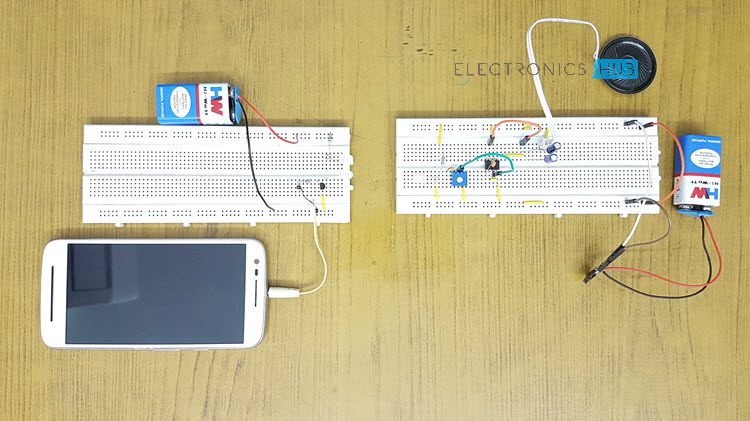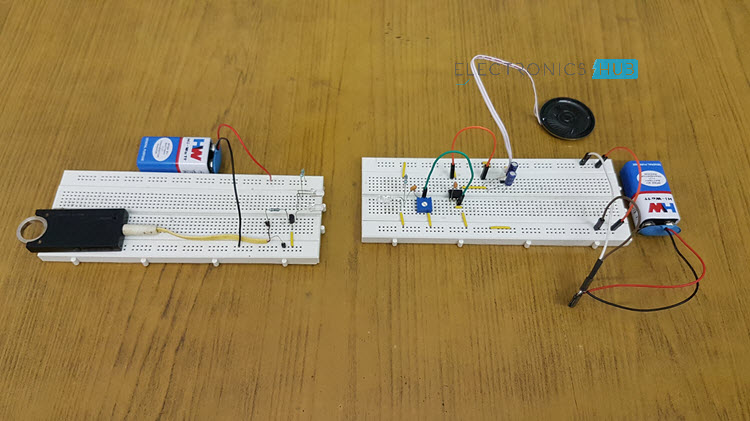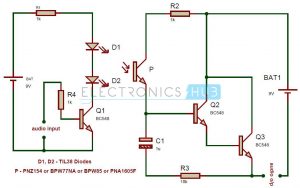Introduction
Wireless Audio is already a technically advanced field where Bluetooth and RF Communications are the main technologies (although most commercial audio equipment works with Bluetooth). Designing a simple IR Audio Link Circuit would not be beneficial when compared to the existing technologies but it surely will be a learning experience about wireless audio transfer. The reason for not being beneficial is the fact that unlike Bluetooth, IR is line-of-sight communication i.e. both the transmitter and receiver must always face each other without any obstacles. Also, the range may not the as large as that of a typical Bluetooth Wireless Audio. None the less, for the purpose of understanding, let me design a simple IR Audio Link circuit using easily available components.
Simple IR Audio Transmitter and Receiver Circuit Principle
The main principle in this circuit is IR communication. Infrared (IR) is used only for line – of – sight communications over low range. In electromagnetic spectrum Infrared rays are rays are having the wavelengths longer than the wavelengths of visible light. These Infrared rays are not visible to the human eye, but we can view these IR rays through the digital camera. A typical IR communication system includes infrared source such as Infrared lasers or LEDs with specific wavelengths. The transmission mediums used for IR communication is vacuum, atmosphere and optical fibers. Finally in IR communication, to detect the IR rays, we will use photo diodes or photo transistors. The output signal from this detectors is very small and might not be able to drive the speakers. Hence, we will use a simple amplifier to amplify the signal. This amplified signal can be able to drive the speakers.
IR Audio Transmitter and Receiver Circuit Diagram
Components Required
Transmitter Section
9V Battery Resistor – 1KΩ X 2 IR Transmitters (IR LEDs) – 2 BC548 NPN Transistor Connecting wires Breadboard
Receiver Section
Photo Diode Resistor – 100KΩ POT – 100KΩ Capacitors – 0.1µF X 2, 10µF, 47µF LM386 Audio Amplifier Connecting wires 8Ω Speaker 9V Battery Breadboard
Simple IR Audio Link Circuit Design
The IR audio link circuit is divided two parts: one is the transmitter section and the other is the receiver section. The transmitter section works with 9V battery. Here, the audio signal input is applied at the base of the Q1 via 1KΩ resistor. Here, the transistor Q1 is used to drive the IR LEDs D1 and D2. The input audio signal is modulated to Infrared signals transmitted. The transmitted Infrared signals are received by the photo Diode. The audio signal is now converter into electrical signal and is further passed to LM386. LM386 is a simple Audio Power Amplifier IC with a maximum output power of approximately 1W. It can drive both 4Ω and 8Ω speakers and in this circuit, I have used a mini 8Ω Speaker. In this circuit, to power the transmitter and receiver sections, I have used 9V batteries. Instead of Photo Diode, you can also use a Photo Transistor like BPW77NA, BPW85, PNA1605F or PNZ154 in the receiver section. NOTE: In case you are using a Photo Transistor, the circuit at the receiver end changes to the following.
How to Operate IR Audio Transmitter and Receiver Circuit?
Simple IR Audio Link Circuit Applications
Used in audio communications to transfer the audio signal from one place to other. Used in short range communications.
Simple IR Audio Link Circuit Limitations
This IR audio link circuit works only for short distances This circuit is not very practical in the sense that there exists a lot of noise and may require some changes to implement it more efficiently.
Comment * Name * Email * Website
Δ









![]()